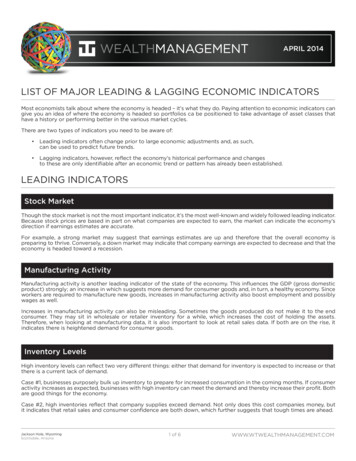
Transcription
APRIL 2014LIST OF MAJOR LEADING & LAGGING ECONOMIC INDICATORSMost economists talk about where the economy is headed – it’s what they do. Paying attention to economic indicators cangive you an idea of where the economy is headed so portfolios ca be positioned to take advantage of asset classes thathave a history or performing better in the various market cycles.There are two types of indicators you need to be aware of: Leading indicators often change prior to large economic adjustments and, as such,can be used to predict future trends. Lagging indicators, however, reflect the economy’s historical performance and changesto these are only identifiable after an economic trend or pattern has already been established.LEADING INDICATORSStock MarketThough the stock market is not the most important indicator, it’s the most well-known and widely followed leading indicator.Because stock prices are based in part on what companies are expected to earn, the market can indicate the economy’sdirection if earnings estimates are accurate.For example, a strong market may suggest that earnings estimates are up and therefore that the overall economy ispreparing to thrive. Conversely, a down market may indicate that company earnings are expected to decrease and that theeconomy is headed toward a recession.Manufacturing ActivityManufacturing activity is another leading indicator of the state of the economy. This influences the GDP (gross domesticproduct) strongly; an increase in which suggests more demand for consumer goods and, in turn, a healthy economy. Sinceworkers are required to manufacture new goods, increases in manufacturing activity also boost employment and possiblywages as well.Increases in manufacturing activity can also be misleading. Sometimes the goods produced do not make it to the endconsumer. They may sit in wholesale or retailer inventory for a while, which increases the cost of holding the assets.Therefore, when looking at manufacturing data, it is also important to look at retail sales data. If both are on the rise, itindicates there is heightened demand for consumer goods.Inventory LevelsHigh inventory levels can reflect two very different things: either that demand for inventory is expected to increase or thatthere is a current lack of demand.Case #1, businesses purposely bulk up inventory to prepare for increased consumption in the coming months. If consumeractivity increases as expected, businesses with high inventory can meet the demand and thereby increase their profit. Bothare good things for the economy.Case #2, high inventories reflect that company supplies exceed demand. Not only does this cost companies money, butit indicates that retail sales and consumer confidence are both down, which further suggests that tough times are ahead.Jackson Hole, WyomingScottsdale, Arizona1 of 6WWW.WTWEALTHMANAGEMENT.COM
MAJOR LEADING INDICATORSRetail salesRetail sales are particularly important metrics and function hand in hand with inventory levels and manufacturing activity.Most importantly, strong retail sales directly increase GDP, which also strengthens the home currency. When sales improve,companies can hire more employees to sell and manufacture more product, which in turn puts more money back in thepockets of consumers.One downside to this metric, though, is that it doesn’t account for how people pay for their purchases. For example, ifconsumers go into debt to acquire goods, it could signal an impending recession if the debt becomes too steep to payback. In general, an increase in retail sales indicates an improving economy.Building PermitsBuilding permits offer foresight into future real estate supply levels. A high volume indicates the construction industry willbe active, which forecasts more jobs and, again, an increase in GDP.But just like with inventory levels, if more houses are built than consumers are willing to buy, it takes away from the builder’sbottom line. To compensate, housing prices are likely to decline, which, in turn, devalues the entire real estate market andnot just “new” homes.Building PermitsA decline in housing prices can suggest that supply exceeds demand that existing prices are unaffordable, and/or thathousing prices are inflated and need to correct as a result of a housing bubble.In any scenario, declines in housing have a negative impact on the economy for several key reasons: They decrease homeowner wealth. They reduce the number of construction jobs needed to build new homes, which thereby increasesunemployment. They reduce property taxes, which limits government resources. Homeowners are less able to refinance or sell their homes, which may force them into foreclosure.When you look at housing data, look at two things: changes in housing values and changes in sales.When sales decline, it generally indicates that values will also drop.Level of New Business StartupsThe number of new businesses entering the economy is another indicator of economic health. In fact, some haveclaimed that small businesses hire more employees than larger corporations and, thereby, contribute more to addressingunemployment.Small businesses can contribute significantly to GDP, and they introduce innovative ideas and products that stimulategrowth. Therefore, increases in small businesses are an extremely important indicator of the economic well-being of anycapitalist nation.Jackson Hole, WyomingScottsdale, Arizona2 of 6WWW.WTWEALTHMANAGEMENT.COM
MAJOR LAGGING INDICATORSUnlike leading indicators, lagging indicators shift after the economy changes. Although they do not typically tell us wherethe economy is headed, they indicate how the economy changes over time and can help identify long-term trends.Changes in the Gross Domestic Product (GDP)GDP is typically considered by economists to be the most important measure of the economy’s current health. When GDPincreases, it’s a sign the economy is strong. In fact, businesses will adjust their expenditures on inventory, payroll, and otherinvestments based on GDP output.GDP is not a flawless indicator. Like the stock market, GDP can be misleading because of programs such as quantitativeeasing and excessive government spending.As a lagging indicator, some question the true value of the GDP metric. After all, it simply tells us what has alreadyhappened, not what is going to happen. GDP is a key determinant as to whether or not the United States is entering arecession. The rule of thumb is that when the GDP drops for more than two quarters, a recession is at hand.Income and WagesIf the economy is operating efficiently, earnings should increase regularly to keep up with the average cost of living. Whenincomes decline, however, it is a sign that employers are either cutting pay rates, laying workers off, or reducing their hours.Declining incomes can also reflect an environment where investments are not performing as well.Incomesare brokendown by different demographics, such as gender, age, ethnicity, and level of education, and theseBuildingPermitsdemographics give insight into how wages change for various groups. This is important because a trend affecting a fewoutliers may suggest an income problem for the entire country, rather than just the groups it effects.Unemployment RateThe unemployment rate is very important and measures the number of people looking for work as a percentage of thetotal labor force. In a healthy economy, the unemployment rate will be anywhere from 3% to 5%.Whenunemploymentrates are high, however, consumers have less money to spend, which negatively affects retail stores,BuildingPermitsGDP, housing markets, and stocks, to name a few. Government debt can also increase via stimulus spending and assistanceprograms, such as unemployment benefits and food stamps.Jackson Hole, WyomingScottsdale, Arizona3 of 6WWW.WTWEALTHMANAGEMENT.COM
MAJOR LAGGING INDICATORSConsumer Price Index (Inflation)The consumer price index (CPI) reflects the increased cost of living, or inflation. The CPI is calculated by measuring the costsof essential goods and services, including vehicles, medical care, professional services, shelter, clothing, transportation, andelectronics. Inflation is then determined by the average increased cost of the total basket of goods over a period of time.A high rate of inflation may erode the value of the dollar more quickly than the average consumer’s income can compensate.This, thereby, decreases consumer purchasing power, and the average standard of living declines. Moreover, inflation canaffect other factors, such as job growth, and can lead to decreases in the employment rate and GDP.However, inflation is not entirely a bad thing, especially if it is in line with changes in the average consumer’s income. Somekey benefits to moderate levels of inflation include: It encourages spending and investing, which can help grow an economy. Otherwise, the value of money held incash would be simply corroded by inflation. It keeps interest rates at a moderately high level, which encourages people to invest their money and provideloans to small businesses and entrepreneurs. It’s not deflation, which can lead to an economic depression.Deflation is a condition in which the cost of living decreases. Although this sounds like a good thing, it is an indicatorthat the economy is in very poor shape. Deflation occurs when consumers decide to cut back on spending and is oftencaused by a reduction in the supply of money. This forces retailers to lower their prices to meet a lower demand. Butas retailers lower their prices, their profits contract considerably. Since they don’t have as much money to pay theiremployees, creditors, and suppliers, they have to cut wages, lay off employees, or default on their loans.Currency StrengthA strong currency increases a country’s purchasing and selling power with other nations. The country with the strongercurrency can sell its products overseas at higher foreign prices and import products more cheaply.However, there are advantages to having a weak dollar as well. When the dollar is weak, the United States can draw inmore tourists and encourage other countries to buy U.S. goods. In fact, as the dollar drops, the demand for Americanproducts increases.Interest RatesI nterest rates are another important lagging indicator of economic growth. They represent the cost of borrowing moneyand are based around the federal funds rate, which represents the rate at which money is lent from one bank to anotherand is determined by the Federal Open Market Committee (FOMC). These rates change as a result of economic andmarket events.When the federal funds rate increases, banks and other lenders have to pay higher interest rates to obtain money. They,in turn, lend money to borrowers at higher rates to compensate, which thereby makes borrowers more reluctant to takeout loans. This discourages businesses from expanding and consumers from taking on debt. As a result, GDP growthbecomes stagnant.Rates that are too low can lead to an increased demand for money and raise the likelihood of inflation. Current interestrates are thus indicative of the economy’s current condition and can further suggest where it might be headed as well.Jackson Hole, WyomingScottsdale, Arizona4 of 6WWW.WTWEALTHMANAGEMENT.COM
MAJOR LAGGING INDICATORSCorporate ProfitsStrong corporate profits are correlated with a rise in GDP because they reflect an increase in sales and thereforeencourage job growth. They also increase stock market performance as investors look for places to invest income.That said, growth in profits does not always reflect a healthy economy.For example, in the recession that began in 2008, companies enjoyed increased profits largely as a result of excessiveoutsourcing and downsizing (including major job cuts). Since both activities took jobs out of the economy, this indicatorfalsely suggested a strong economy.Balance of TradeThe balance of trade is the net difference between the value of exports and imports and shows whether there is a tradesurplus (more money coming into the country) or a trade deficit (more money going out of the country).Trade surpluses are generally desirable, but if the trade surplus is too high, a country may not be taking full advantage ofthe opportunity to purchase other countries’ products.Trade deficits, however, can lead to significant domestic debt. Over the long term, a trade deficit can result in adevaluation of the local currency as foreign debt increases.Value of Commodity Substitutes to U.S. DollarGold and silver are often viewed as substitutes to the U.S. dollar. When the economy suffers or the value of the U.S.dollar declines, these commodities increase in price because more people buy them as a measure of protection. They areviewed to have inherent value that does not decline.Because metals are priced in U.S. dollars, any deterioration or projected decline in the value of the dollar must logicallylead to an increase in the price of the metal. Precious metal prices can act as a reflection of consumer sentiment towardsthe U.S. dollar and its future. For example, consider the record-high price of gold at 1,900 an ounce in 2011 as the valueof the U.S. dollar deteriorated.Final WordTo accurately characterize the state of the economy, you must rely on the analysis of others without a particular agenda.Keep in mind that most economic indicators work best in conjunction with other indicators. At WT Wealth Managementwe feel that analyzing economic data allows us to make better decisions regarding portfolio design and construction.Jackson Hole, WyomingScottsdale, Arizona5 of 6WWW.WTWEALTHMANAGEMENT.COM
LIST OF MAJOR LEADING &LAGGING ECONOMIC INDICATORSDisclosureWARRANTIES & DISCLAIMERSAn investment in the fund(s) is not insured or guaranteed by the Federal Deposit Insurance Corporation or any othergovernment agency.Any opinions expressed are the opinions of WT Wealth Management and its associates only. Information is neither an offerto buy or sell securities nor should it be interpreted as personal financial advice. You should always seek out the adviceof a qualified investment professional before deciding to invest. Investing in stocks, bonds, mutual funds and ETF’s carrycertain specific risks and part or all of your account value can be lost.In addition to the normal risks associated with investing, narrowly focused investments, investments in smaller companies,sector ETF’s and investments in single countries typically exhibit higher volatility. International and Emerging MarketETF’s investments may involve risk of capital loss from unfavorable fluctuations in currency values, from differences ingenerally accepted accounting principles or from economic or political instability in other nations. Emerging marketsinvolve heightened risks related to the same factors as well as increased volatility and lower trading volume. Bonds andbond funds will decrease in value as interest rates rise. A portion of a municipal bond fund’s income may be subject tofederal or state income taxes or the alternative minimum tax. Capital gains, if any, are subject to capital gains tax.Diversification and asset allocation may not protect against market risk or a loss in your investment.At WT Wealth Management we strongly suggest having a personal financial plan in place before making any investmentdecisions including understanding your personal risk tolerance and having clearly outlined investment objectives.WT Wealth Management is a registered investment adviser located in Jackson, WY. WT Wealth Management may onlytransact business in those states in which it is registered, or qualifies for an exemption or exclusion from registrationrequirements. Any subsequent, direct communication by WT Wealth Management with a prospective client shall beconducted by a representative that is either registered or qualifies for an exemption or exclusion from registration in thestate where the prospective client resides. For information pertaining to the registration status of WT Wealth Management,please contact the state securities regulators for those states in which WT Wealth Management maintains a registrationfiling.A copy of WT Wealth Management’s current written disclosure statement discussing WT Wealth Management’s businessoperations, services, and fees is available at the SEC’s investment adviser public information website – www.adviserinfo.sec.gov or from WT Wealth Management upon written request. WT Wealth Management does not make any representationsor warranties as to the accuracy, timeliness, suitability, completeness, or relevance of any information prepared by anyunaffiliated third party, whether linked to WT Wealth Management’s web site or incorporated herein, and takes noresponsibility therefor. All such information is provided solely for convenience purposes only and all users thereof shouldbe guided accordingly.Jackson Hole, WyomingScottsdale, Arizona6 of 6WWW.WTWEALTHMANAGEMENT.COM
Leading indicators often change prior to large economic adjustments and, as such, can be used to predict future trends. Lagging indicators, however, reflect theeconomy's historical performance and changes to these are only identifiable after aneconomic trend or pattern has already been established. Stock Market Manufacturing Activity










